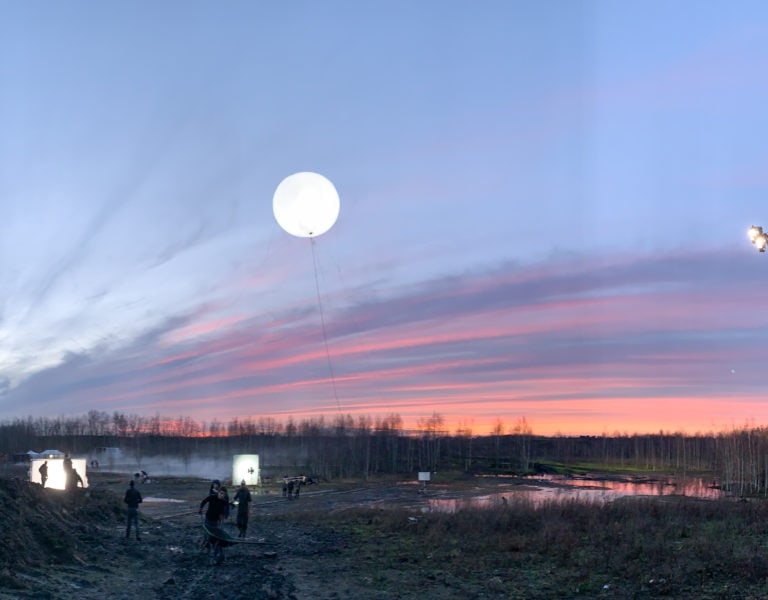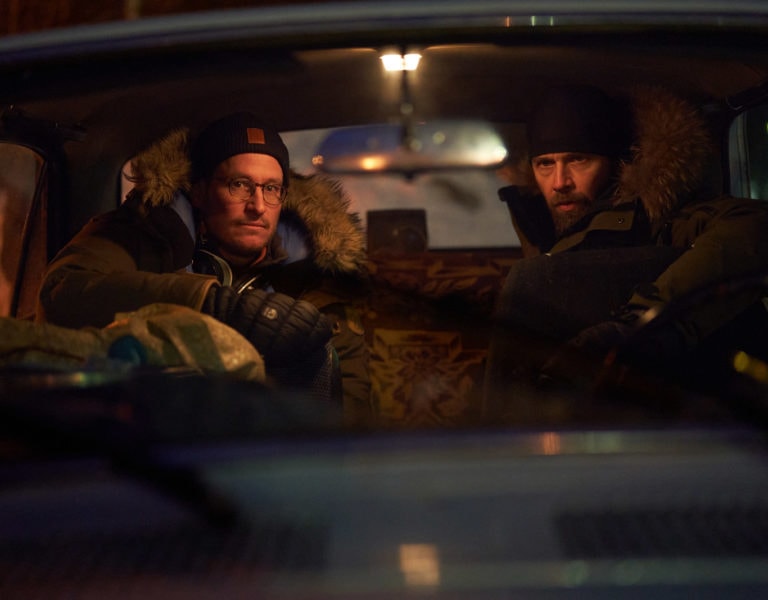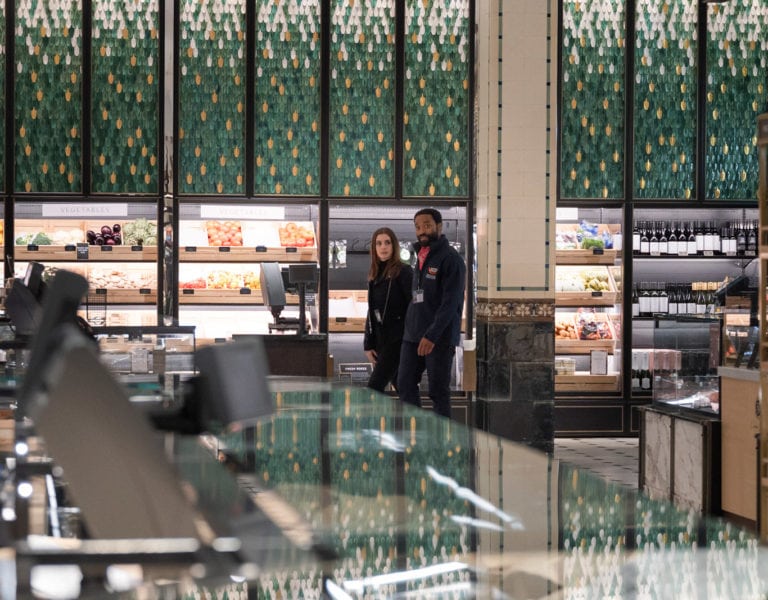REVENGE IS UPON US
New techniques were investigated, and valuable lessons were learnt as The Northman cinematographer Jarin Blaschke and director Robert Eggers crafted the filmmakers’ most ambitious and rewarding production alongside their revered collaborators.
ach time writer-director Robert Eggers reveals his latest concept it “feels like Christmas has come early”, according to cinematographer and long-time collaborator Jarin Blaschke. “I wish I could say I love Vikings and vengeance, but that wasn’t what specifically appealed to me when Rob shared the idea for The Northman,” he says.
“Essentially, anything he creates, I want to get involved with. His films transport you like time machines. Rob sees a vibe or an atmosphere first which he then writes from. So, normally there is a look book before a script, which whets your appetite. And then when you receive the script you already know how to visualise it.”

On this occasion, Egger’s vision transports audiences to the Viking Age as they join warrior prince Amleth (Alexander Skarsgård) on a quest for retribution following his father’s murder. The action-packed story – written by Eggers and Icelandic novelist and poet Sjón – is based on the legend of Amleth, an ancient Scandinavian figure who inspired Shakespeare’s tragedy Hamlet.
Like Blaschke, Eggers has not had a life-long fascination with Viking history. “That didn’t interest me as a kid, but when I visited Iceland, the landscapes were so incredibly epic, inspiring, brutal, and otherworldly and that got me interested,” says the director.
“After reading some Icelandic sagas I thought maybe one day I could make a Viking movie. Two years later, I had lunch with Alexander Skarsgård, who had been interested in Vikings since his youth and had been trying to make a Viking movie for years. We left that lunch agreeing we would do something together.”
Jarin, more than ever, was an authorial voice of the cinematic language. Often, he came up with scene concepts and then asked me for notes. This worked well because we know and trust each other; he sees into my mind.
Robert Eggers
The cinematic language of the film is, Eggers points out, an extension of his and Blaschke’s work on their short films and two previous features – The Witch (2015) and The Lighthouse (2019) – where they “tried to eliminate excess and simplify to the essential elements”.
“The Northman is so bombastic that saying I’m limiting excess seems crazy, but as far as the cinematic language goes, aside from a few scenes with witches that are shot/reverse shot, we mostly shot long, unbroken takes,” he says. “It’s also faster paced than our other films. The camera is always moving and trying to draw you in, keep you engaged, and suck you into that world.”
Blaschke agrees the production is a change in direction and “more mainstream”, increasing their learning curve exponentially. “This was a huge challenge,” he says. “But I’d rather risk drowning than not grow.”
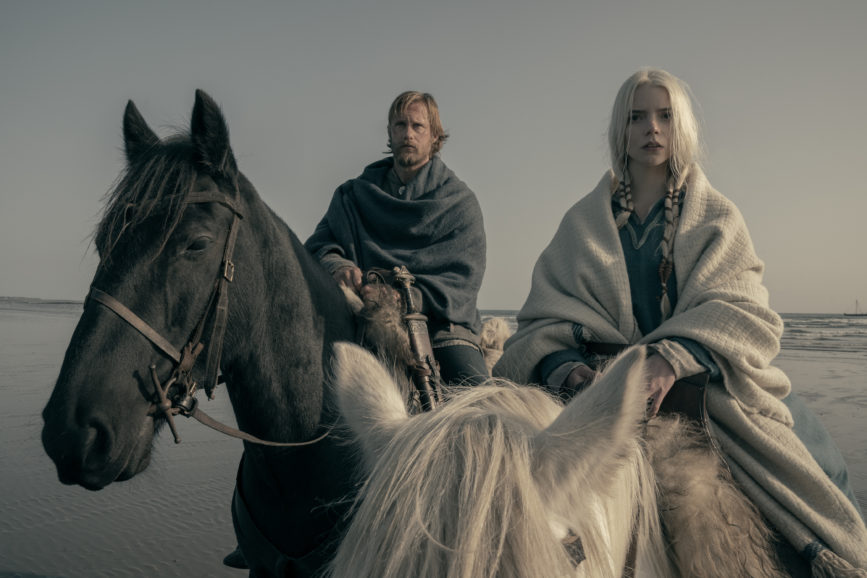
It’s that shared ambition and perfectionism that the cinematographer believes is central to their lengthy and rewarding partnership. “Even in 2008, when we shot our first short, Rob almost encouraged the fussing that I would normally get in trouble for. Any quirks or wacky ideas that are, often on the independent scene, seen as faults, Rob supported.”
The Tell-Tale Heart (2008) – a psychological thriller and adaptation of Edgar Allan Poe’s story – was their first short film together as well as Blaschke’s first period film. With the pair’s latest period creation having a vastly largely budget ($90 million) than their more confined and stripped back productions, Blaschke was excited by the opportunity it presented to try out longstanding ideas and techniques he had not had the resources to explore.
He admits that due to their independent background there “was no real way to prepare completely” for what was to come. “We just had to test a lot, everything from film stocks to how to filter for the night work which looks almost black-and-white. I was trying out completely new processes to achieve the results I wanted.”
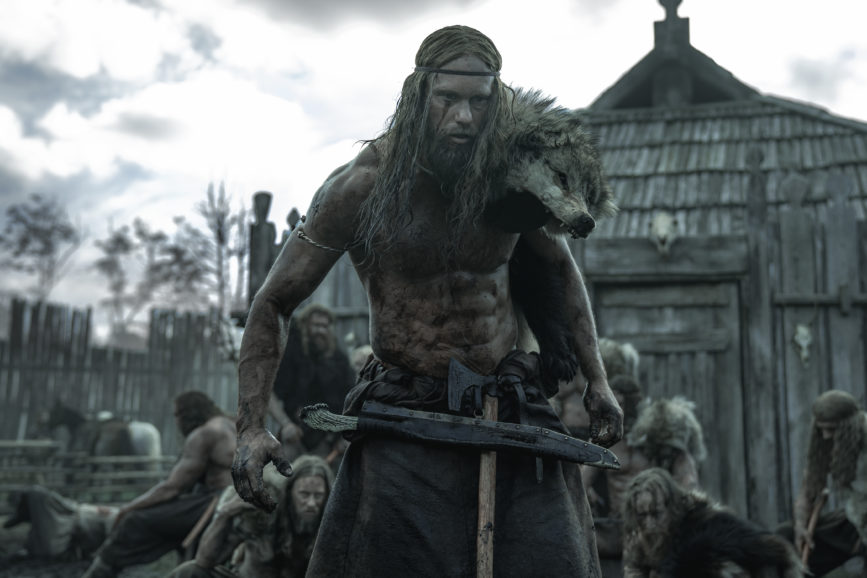
New scope
The Northman benefitted from a long prep period due to the pandemic, in addition to the months Blaschke and Eggers usually spend discussing their movies. The initially planned four months of prep, with shooting expected to commence in March 2020, turned into eight months. “With our lack of experience of this scale of production, this extra time was helpful, even critical,” says Blaschke, who skipped the shot list stage and went straight to storyboards, offering Eggers a few options when possible.
As prep progressed, Eggers’ time was increasingly split between multiple teams on the vast production. “Jarin, more than ever, was an authorial voice of the cinematic language,” says Eggers. “Often, he came up with scene concepts and then asked me for notes. This worked well because we know and trust each other; he sees into my mind.”
During prep, Soviet cinema was frequently referenced by Eggers, in particular Andrei Tarkovsky’s Andrei Rublev (1966), lensed by Vadim Ysov. “Rob thinks the bell sequence at the end is perfect,” says Blaschke. “With that in mind, in The Northman, he mainly wanted longer takes and a lot of density and layered richness within them. It was almost a personal dare to see if we could incorporate that formalism into a mainstream movie.”
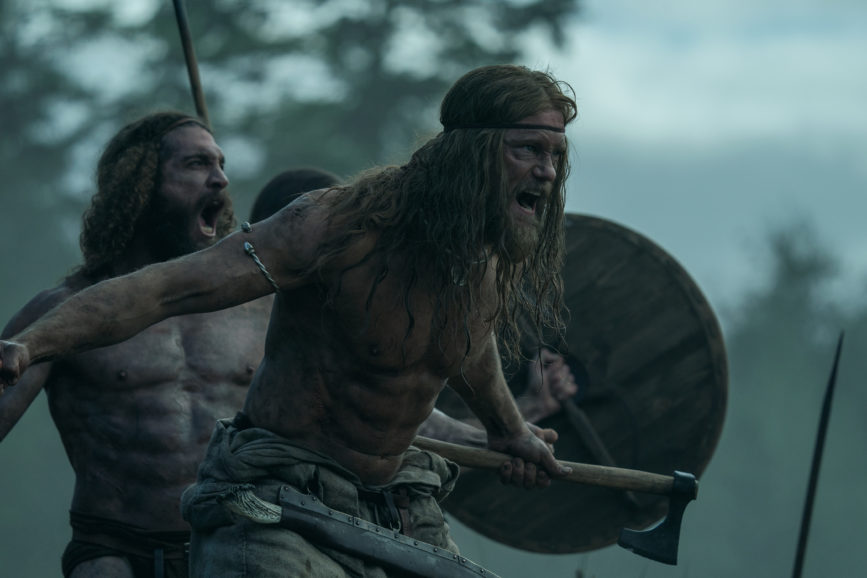
The influence of Miklós Jancsó’s The Round-Up (1966) can also be seen in some sequences featuring slaves. “We also paid a lot of attention to the staging of Akira Kurosawa’s battle scenes, despite him shooting with multiple cameras, unlike us,” adds Eggers. “John Millius’s Conan the Barbarian (1982), which I’ve seen so many times, also has a large presence in the film.”
The filmmakers generally use art from the period as a springboard to understand a production’s visual language. “But Viking art is very stylised and doesn’t have much atmosphere,” says Eggers. “We brought some of that formalism and symmetry, along with the Nordic starkness, into our approach, but the landscapes became the main inspiration for the visuals and atmosphere. It became about mud, sleet, snow, ice, and fire.” Blaschke also did not find Viking carvings and tapestries a very useful reference as “there’s no real photographic or film texture that feels appropriate – it just feels superfluous.”
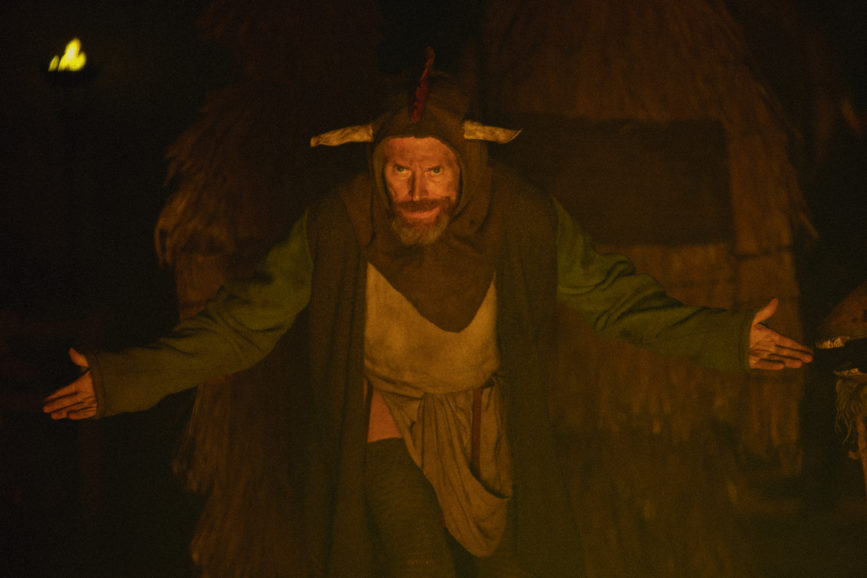
Aware of Eggers’ preference for a symmetrical frame, Blaschke knew the visuals would be centre weighted with no extreme negative space or modern frames as “compositionally, Rob doesn’t generally stray far from the Renaissance.”
Selecting aspect ratio was more involved. Normally, Eggers is fond of shooting 1.33:1 which they have adopted for some previous films. On this occasion, they were torn between 1.85 and 2:1, so Blaschke drew rectangles on a grid page to help them decide. “2:1 felt more classical and most suitable as there are many more people in frame being balanced against the landscape,” he says. “But any wider than that, would feel contemporary.”
This also informed their decision against shooting with anamorphic lenses because it “felt too much like a movie. I’m shooting my current movie anamorphically. It’s a format I like a lot for certain situations but it’s not for Rob. It’s too baked into cinema itself, particularly late cinema.”
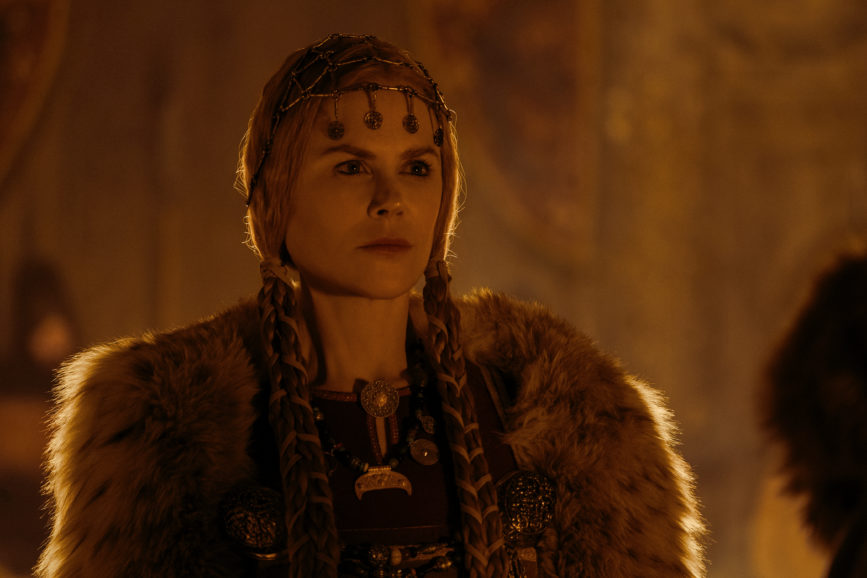

Recreating a Nordic world
While the story takes place in 10th century Iceland and that was where Eggers had originally intended to shoot half of the film, plans changed, partly due to pandemic travel restrictions. Instead, locations in Northern Ireland and some in the Republic of Ireland, which had been selected for the other half of the movie, doubled up for Iceland for the majority of the production.
“Aside from the pandemic limitations, Iceland is expensive to shoot in, so we knew most of Iceland would need to be recreated elsewhere, which basically meant Ireland or Scotland,” says Eggers. “Often, the foreground and mid ground is Ireland with a background photographic plate of Iceland. It’s not sinful and many people do it, but it’s not the way Jarin and I particularly like to make movies. So, that was a compromise we didn’t always love, but we had no choice.”
Locations used in Northern Ireland include Clandeboyne Estate in County Down, where the Slavic village that Amleth and his Viking army ambush was created; Torr Head, where the kingdom of Amleth’s father King Aurvandill’s (Ethan Hawke) was built on a slope; and the River Bann, where the rowing scene prior to the raid of the Slavic village was filmed. Elsewhere, a set was constructed at Knockdhu, County Antrim, to recreate the Icelandic farm belonging to Amleth’s uncle Fjolnir, who murdered Amleth’s father. The climactic battle scene beside a volcano at the Gates of Hell was also filmed in County Antrim, at Hightown Quarry.
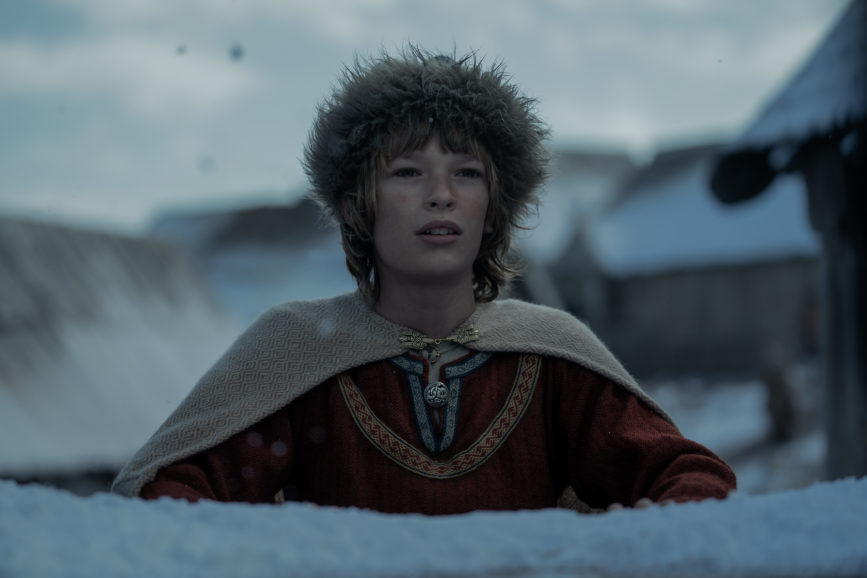
Prior to the 87-day shoot, supervising location manager Naomi Liston (Game of Thrones, Avengers: Endgame) faced significant challenges whilst arranging access to locations and making them serviceable.
“For us to film the scene when they play the Icelandic Viking ball game knattleikr, Naomi had to organise for a road to be built so we could get to the remote shooting location in the Mourne Mountains in County Down,” says Eggers. “It was a 45-minute hike for the crew and I. The actors had to be helicoptered in.”
Due to Northern Ireland’s stunning locations complete with breathtaking mountains and coastline, and its likeness to the Icelandic landscape, only six days of additional photography in Iceland were required to capture scenes taking place at the Icelandic glaciers. These were shot at Svínafellsjökull at the Icelandic Natural Reserve, and village scenes were filmed in the city of Akureyri. These sequences were mainly captured to strengthen Amleth and Olga’s (Anya Taylor-Joy) relationship.
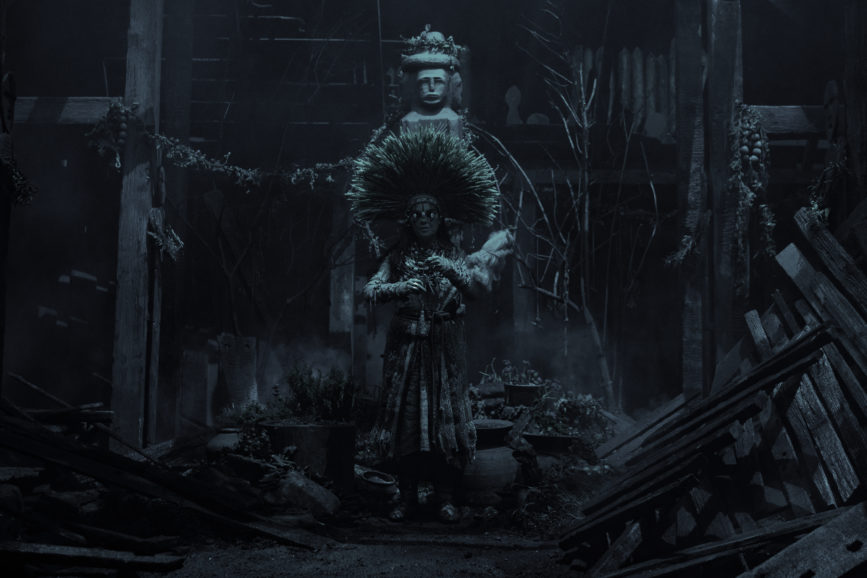
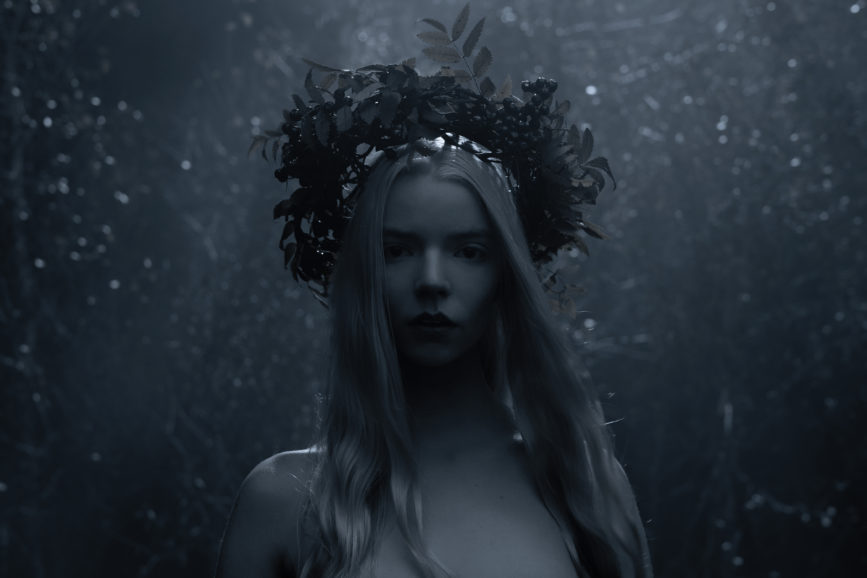
“We eventually got to Iceland to shoot that handful of sequences. Jarin and I were also remotely directing an aerial unit over there,” says Eggers. “So, while shooting in Ireland, we were using a handheld monitor to direct the camera operator capturing scenes in Iceland.”
Scenes shot on stage at Belfast Harbour Studios included those in the underground chamber; the hall; and the sorcerer’s cave. Blaschke found the studios to be an “excellent space with the high ceilings and space the production demanded.”
Liking to work holistically and light naturalistically, the cinematographer worked in parallel with production designer Craig Lathrop to ensure the spaces incorporated the lighting requirements for each stage of the story. “How large a smoke hole is to let in light makes a huge difference, so we were in constant dialogue,” he says. “Much of the atmosphere is created by Craig and he did a lot of practical things such as creating doorways with a guillotine top to allow a crane to telescope through.”
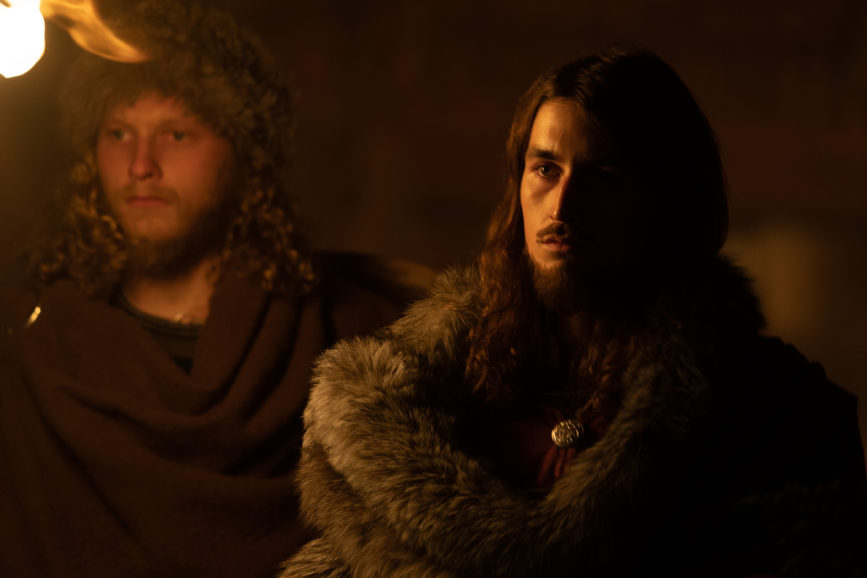
Eggers also believes the film “couldn’t have been achieved without” working with repeat collaborators: “Jarin, costume designer Linda [Muir], production designer Craig, editor Louise [Ford], and I don’t know how to do it any other way than we have in the past, so we just repeated that process, only on a much larger scale.
“Sometimes, we had to learn on our feet to achieve such enormous ambitions. But luckily, we had an incredibly experienced crew across the board who’d worked on productions such as Game of Thrones, Ridley Scott movies, and Harry Potter. They knew how to make a film like this.”
Plans created by Lathrop were explored with Blaschke and Eggers before models were built, allowing quick and easy placement of buildings to visualise the path the camera would follow. Blaschke also created a map for each lens to enable him to see the camera’s view as buildings were repositioned on the model.

An omniscient camera
The camera ruled over every decision made, with its movement determined by practicality and how best to distill a scene using the most direct presentation which often required forcing blocking to fit a simplified movement. “Chris Plevin operated A cam and it was so technical and all on wheels, which I never learnt,” says Blaschke. “So the operating is all him, with me very much over his shoulder.
“As the movie is about fate, an omniscient camera made sense. It’s just catching things. There’s a danger of it almost looking convenient, but that’s in line with the theme of fate and this immutable camera which things are happening to.”
The Northman was mostly captured with a Panavision 35mm Millennium XL2, supplied by Panavision. “It’s pretty compact which was useful,” says Blaschke. “We also did a lot of remote head work with the Libra supplied by Camera Revolution, meaning I rarely was able to look through an eye piece.”
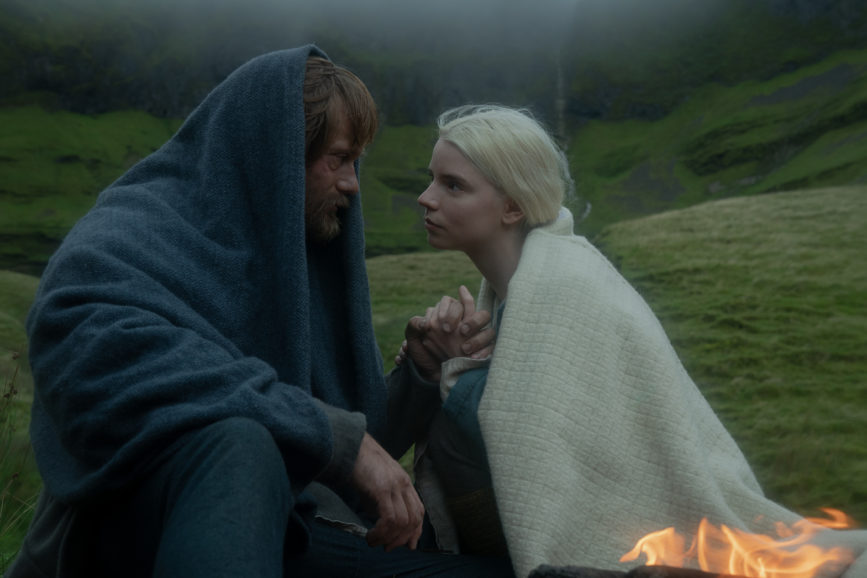
Clean, high-speed lenses were an essential requirement, with Panavision’s high-speed Primo deemed the best solution following testing. Although Blaschke liked the Primos most, he “wasn’t keen on its spiky iris which means that anything out of focus, such as a single flame, would adopt a starred pattern.” As a result, Panavision’s Dan Sasaki customised the lenses, so they featured a round iris. He also made the highlights glow a little more and built in some barrel distortion, per Blaschke’s request.
“The Northman is our cleanest movie so far and likely will ever be – using pretty clean optics and fine grain film,” says Blaschke. “I can’t see us going more direct than this. But while the lack of texture is immersive, the shot structure is maybe a little aloof on purpose.”
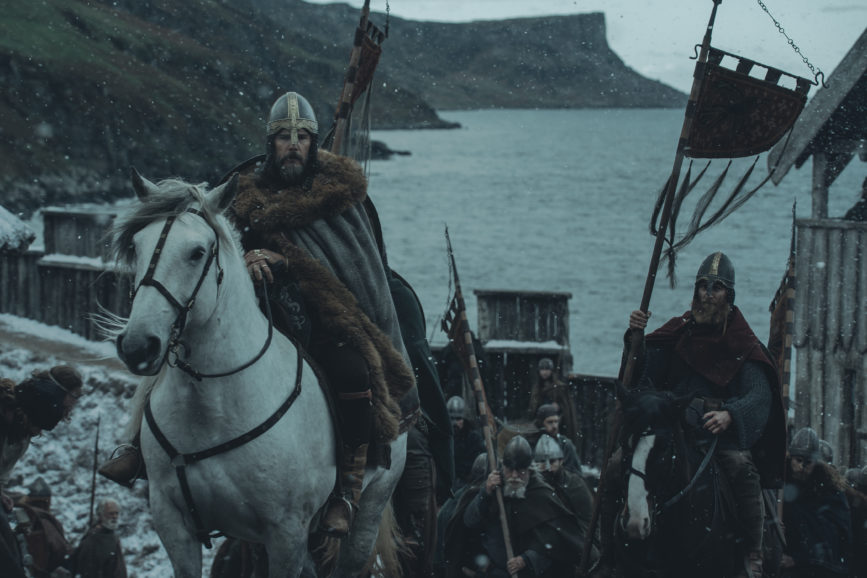
The Place of Visions family tree sequence required high-speed work using a Panavised 435 and a motion control rig running at 120fps. “It was the fastest film camera we could put on the rig, but I was hurting for light even more than usual at 1/250th of a second, shooting Kodak 5203 and rating it at ei 32.”
Handheld photography was deemed inappropriate for the film and there was only a minimal amount of Steadicam – 12 shots for the sequence captured in the Mourne Mountains. “We really don’t like Steadicam work, but that remote location demanded it because we had to reach it by helicopter and couldn’t get our usual crane there,” says Blaschke.
Ever since we’ve been able to shoot on film, that’s what Rob and I have opted to do.
Jarin Blaschke
He also assigns the triumph of scenes such as the Slavic village ambush to “phenomenal” key grip Darren “Dutch” Holland and his team. “We’d make up shots from our imagination and he’d figure out how to get the camera from A to B. When the crew first got on location, Dutch gave us feedback on how locations would work practically, so we could finalise the camera path. Having the time and people to really think things through was a huge benefit of the larger budget.”
The Slavic village scene – which is only 90 seconds long but action-packed – was also achieved through determining how best to invisibly stitch one shot into the next in as few shots as possible or how to get to a point where a cut marks a clear beat change in a scene. The sequence comprises of four shots captured on four days, with the aftermath scene made up of three shots.
“This required conversations around whether the camera should be on a dolly, a dance floor, or another crane,” says Blaschke. “We also had wonderful holistic discussions with visual effects supervisor Angela Barson and her team about how to make the long shots happen and hide the cuts. We would love to work with her again.”
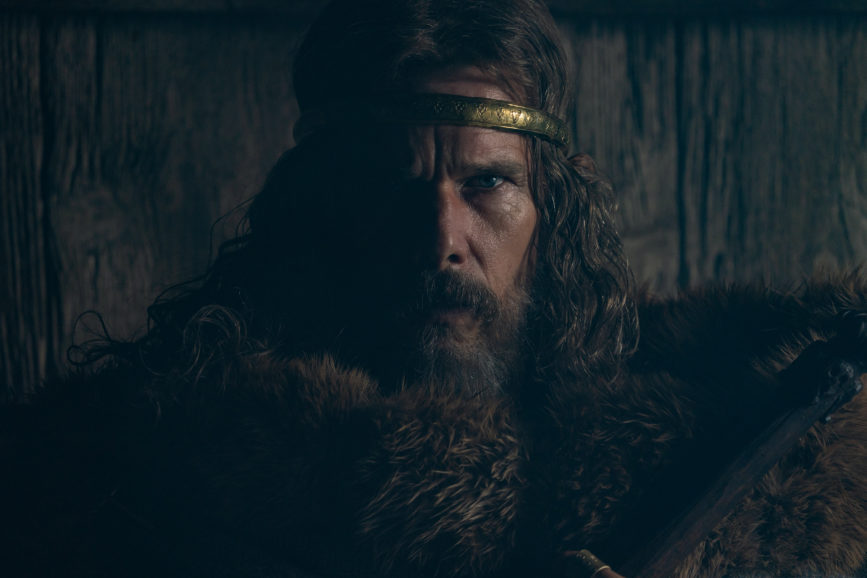
BlueBolt was brought on board as lead VFX vendor – with Barson as the overall VFX supervisor heading up the team – to create the extensive visual effects required including environment work, and creating CG ships, water, and creatures.
“Robert and Jarin were very keen to film as much as possible in camera,” she says. “However, with an erupting volcano, a character without a nose, and a fight on an active lava field, VFX was always going to play a big part. There are some very complex shots in the film that required a lot of planning, especially the invisible stitches for the scenes which ended up being one long shot.”
Eggers highlights the scene of the storm at sea as one of the most “successful and completely photo realistic” effects examples. “However, I feel, due to mine and Jarin’s inexperience with visual effects, there are still things that could be improved if we were involved even earlier in our next film, so we could hash out ideas to make it even more seamless. We would also aim to get involved earlier in the grading process, which on this occasion was expertly handled by colourists Vanessa Taylor and Adam Glasman but was delayed by the pandemic.”

The romance of celluloid
“Ever since we’ve been able to shoot on film, that’s what Rob and I have opted to do,” says Blaschke. “We like the way it renders colours. It instantly feels less contemporary. Digital is good for some things, but it’s an atmosphere killer for what Rob’s looking to achieve.
From a director’s standpoint, when shooting an atmospheric film such as The Northman, Eggers finds working with the organic film format to be in keeping with the story being told. “And as I’m drawn to the past, I prefer the romance of the celluloid image,” he adds.
The Northman was shot on all 35mm film stocks available, bar black-and-white and with less reliance on fast film. “We tested 65mm but ultimately the producers didn’t go for it,” says Blaschke. “But after being seduced by the large format image, I just wanted everything to be smooth and as clean as I could present it on film, so I shot it on the slowest stock possible for a given situation. This required a lot of light and meant we couldn’t use real fire unless it was roaring.”
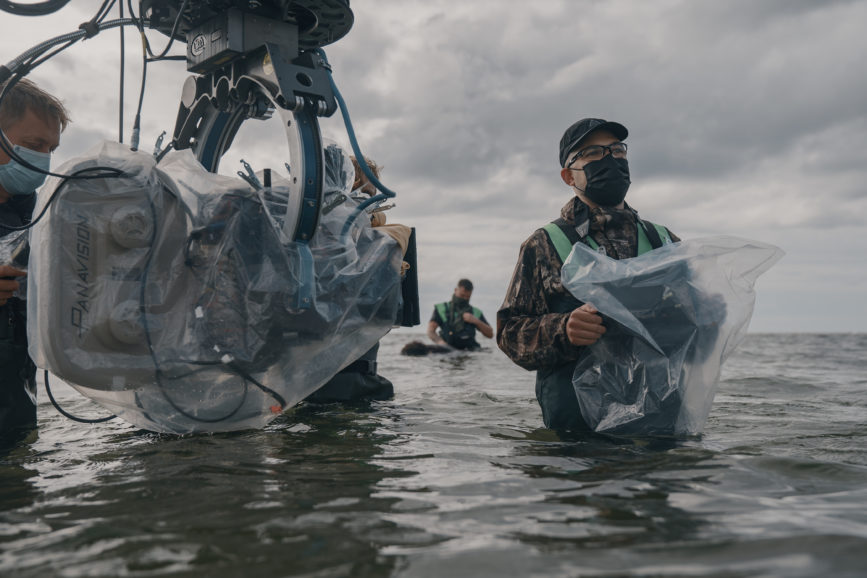
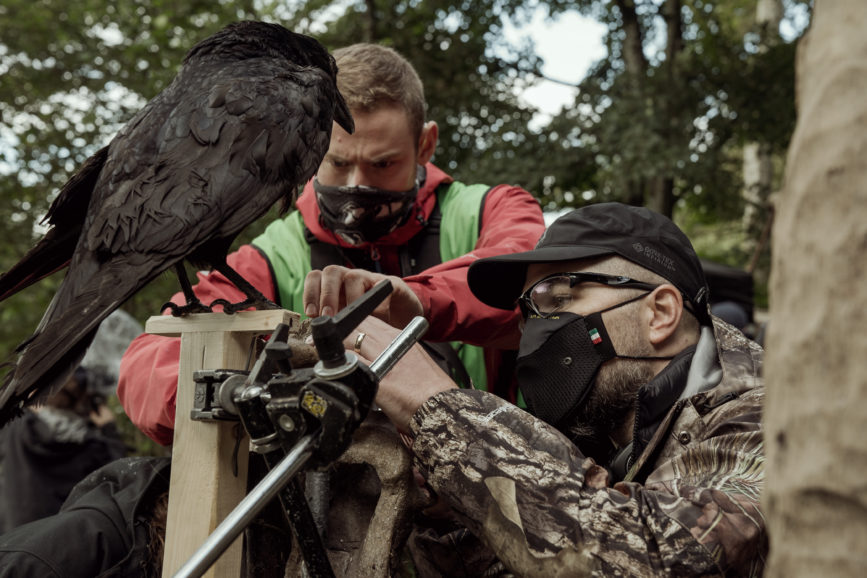
The low-speed Kodak Vision3 50D 5203 was used as much as possible, as well as Vision3 250D 5207, and Vision3 200T 5213, with all processing taking place at Cinelab in London. Lighting ratio lessons were learnt from “playing in the shadows” during the night work. “It was also about getting used to how some night exteriors look on set compared to the final results,” he says. “I experienced this on The Lighthouse, which was a similar light level, but on that film I was lighting a room, not hundreds of yards of farmland at night.”
The final battle scene beside the volcano was shot at 32 ASA on Kodak Vision3 50D 5203, as were any daylight exterior scenes, up until the light levels in Ireland diminished in November. He finds it to be the softest stock Kodak offers – “smooth, with no grain, and a lovely velvety texture.” (moved) The 250 Daylight (5207) was a backup in case of especially gloomy weather and used a lot less than expected. “It still looks great, and despite the extra grain it’s actually sharper than the 50D,” he adds
All moonlit and firelit scenes were shot on Vision3 200T 5213 which Blaschke rated at ei 80 to achieve a “proper” black. The film stock also created a “2D edge” when working with Blaschke’s preferred hard light for nocturnal scenes, created using convex mirrors to optically shrink the light source for sharper shadows.
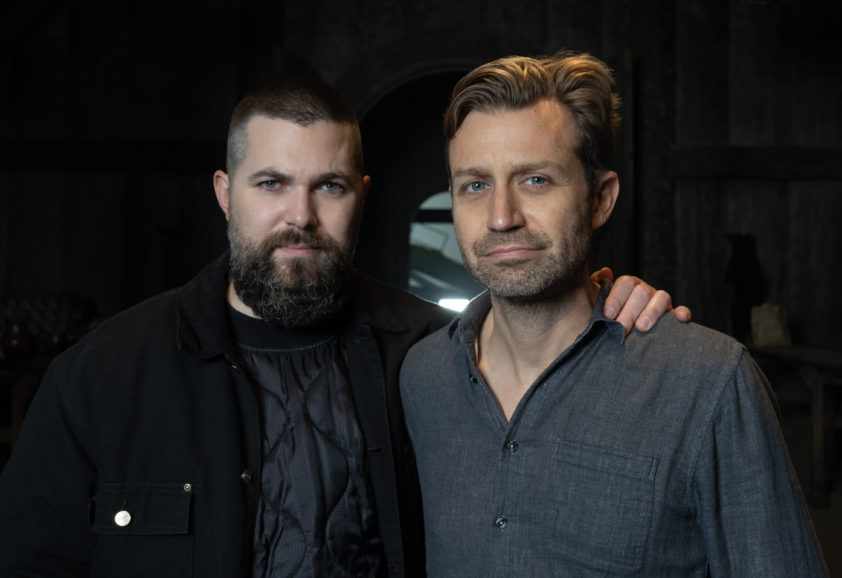
Seeing the light
Much of the night work was shot working with a formula Blaschke developed to mix regular saturation with black-and-white – an idea which was spawned whilst visiting remote African locations that were free from light pollution. The summer prior to making The Northman, whilst climbing Mount Kilimanjaro, Blaschke noticed that although the moonlit mountain looked monochromatic, the tents at the campsite were in full colour from people shining flashlights from inside.
“My eyes were seeing black-and-white and colour at the same time, depending on how much light in my field of view was emitted” he says. “I wanted to work out how we might present that on screen.”
Five months later, Blaschke was immersed in the search for a method to create a unique form of desaturated moonlight. Early tests using regular colour temperature blue gels failed to produce the desired results. “Because it was on-hand, I then tried the short pass filter from The Lighthouse that eliminates red light completely. Of course, the dailies were a crazy cyan colour which you’d never want, but when I desaturated that, it looked spot on.”
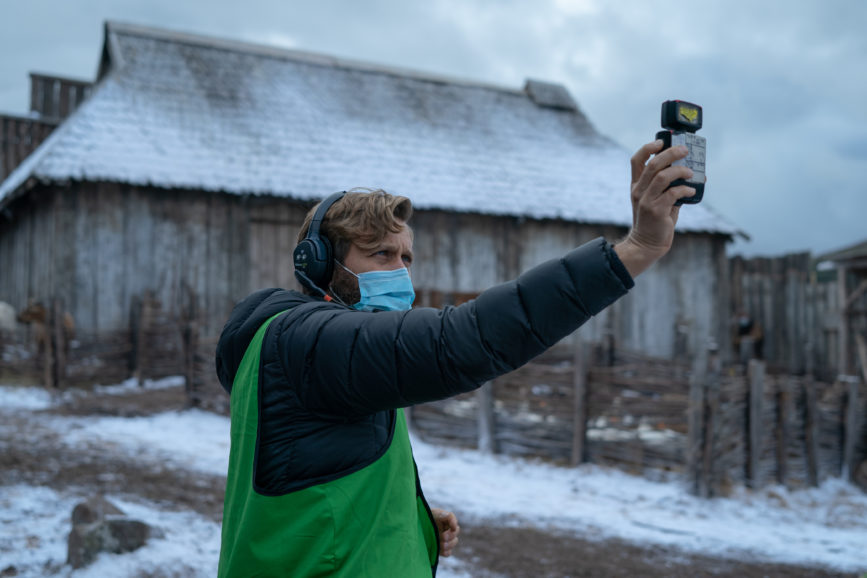
Blaschke discovered that eliminating all red light and then desaturating produced close to the monochromatic result he sought, as the human eye is insensitive to the red spectrum at very low light levels. So, he thought about how he could mix that without power windows in the grading process changing the saturation.
“Eventually, while trying to get to sleep one night, a crazy idea occurred to me. What if the red-eliminating shortness filtration happens on the lights as a pure cyan gel? You would have regular firelight and pure cyan moonlight in the same frame,” he says. “If I then put a regular CC 40 cyan filter on the camera, that won’t affect the gel moonlight at all. It will be the same – you can’t lose any more red from pure cyan. So, the moonlight portion of the image passes through the filter untouched, but the CC cyan filter on the camera will gently skew the firelight portion to be less red. The last step is then to add back the red in the printing to get the right color in the firelight. There’s enough red information there to bring it back to normal but with zero red information in the moonlight, so that simply desaturates when printed red.”
To guarantee the best results, Blaschke needed to work with a film stock offering the right speed ratio across the colours. “Daylight film is more sensitive to red light than tungsten film, and you also need more sensitivity in that colour to counteract the cyan filter,” he explains. So moonlight-firelight mixed night scenes were shot on Kodak 5207.

Blaschke used existing lighting gels – lagoon blue for scenes featuring campfires and flaming torches and special steel blue for those without fire – to negate the colour red from the image at night, so that when it was reintroduced in post, it created a monochrome effect. Going forward, he is keen to develop the method further by collaborating with a manufacturer as the extant gels lost 2 1/3 and 2 stops of light respectively and he admits the “shadows tend to look a little purple after it’s printed.”
“I’d love to work in partnership with someone as working with existing party gels is very inefficient. Shooting night exteriors and illuminating a huge territory at 80 ISO when the gels took almost three stops of light, meant we used a shameful amount of power. A custom shortpass gel, or even better, shortpass dichroic filter for the lights would at least double the output of a light.”

“Mike Carter at Panavision connected me with Ron Engvaldsen at Schneider to develop a custom day for night filter, an updated version of the shortness filter from The Lighthouse. As it was much more efficient and convenient than gelling all of their HMIs, it was used for moonlit scenes that did not mix with firelight.
Eggers is also eager to advance the technique and admits the moonlit scenes might appear unusual to some who do not realise what the filmmakers were trying to achieve. “They might wonder what this strange black-and-white stuff is,” he says. “As some people are so used to movie night which is actually really quite stylised, to them, our take on naturalistic night lighting looks stylised in comparison. That’s something we’d like to evolve.”

Realising the concept
In their first meeting, when gaffer Seamus Lynch asked Blaschke how he envisioned his moonlight, the cinematographer replied, “The biggest HMI I can find, smashed into a silver ball.”
From then on Lynch knew this film was going to be different. “Although Jarin’s overall lighting concept was simple – daylight, moonlight, or firelight were our only sources – the remote locations, buildings with no windows, and film stock which meant we never shot above 100 ISO, provided their own challenges in realising that concept,” says Lynch.
From widening smoke holes in the roof to providing enough “real” fire in interiors to enable shooting at 100 ISO, production designer Lathrop, assistant construction manager Peter Brown, and special effects supervisor Sam Conway and Terry Palmer helped achieve Blaschke’s goals.

Daylight interiors were never cheated. If a light came from an open door or a fire in the middle of the room, then that was their source. While this may sound simple, Lynch emphasises that “trying to hit f2.8 ½ when shooting at 100 ISO and physically getting enough light into the room, whether that be daylight, real, or false fire, without cheating the source was a challenge.”
Day exteriors were not actively lit, although 20 x 12 bleached muslin was frequently used as a passive bounce and 20 x 12 double and triple nets as negative fill. This meant the wind tested rigger Paul Toman and wind speed and direction were constantly monitored. The bleached muslin bounces with a criss-cross lattice effect of sharks-tooth white net sewn in were created in partnership with Phil Leonard at Daylight Textiles to minimise wind resistance and maximise their usage. They were also used on the SkyPanel bounce machines at night for the same reason.
The main lighting setup in the studio was the longhouse set, where the only daylight sources came from the smoke hole in the roof. HOD rigger Hugo Wilkinson and rigging gaffer Gareth Hetherington and Lynch created a bleached muslin-lined chimney, which was lowered by electric motors over an enlarged smoke hole. This was hit with 18k Arrimax at varying degrees of spot and flood to bounce daylight into the longhouse set.
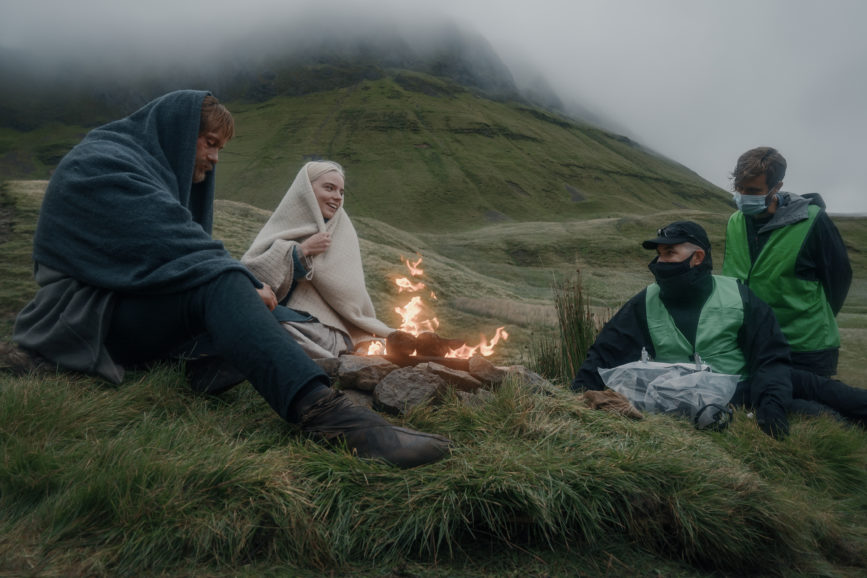
The focal point of the set – the 12ft x 4ft firepit in the middle of the set which alternated between fake and real fire – was the result of a collaboration between Lynch, Lathrop, Conway, and Palmer from special effects. Lynch and his team ducted their cables under the floor so they could be removed when reverting to real fire.
For the first camera test, which was shot at f2.8 ½ at 100 ISO, dimmer op Gino Lynch created a fire effect. This video of a real fire was bit mapped and played through an MA Lighting grandMA 2 across a wall of Astera tubes on 16-pixel mode, producing a realistic fire flicker with believable shadow shift. “Jarin liked the concept but wanted to know if we could apply the same principle to a wall of tungsten bulbs, which we did, with each bulb becoming a pixel,” says Seamus Lynch.
As fire is omni-directional, a Socaplex fed conical rig was built and covered in 280 500-watt bulbs. Different sizes of rig – which became known as The Dalek – were built to emulate various sizes of fire. Each Dalek wore a coat of full CTO and 1/4 minus green gel as the bulbs needed to be colour corrected from 3200 kelvin down to 1850 kelvin to match the colour of real fire and flaming torches provided by SFX. Due to the heat generated, this gel coat was changed regularly.

The interior cave and tunnel scenes were simply lit by real fire, a Dalek, or a combination of both, with bleached muslin bounce and Gino Lynch’s fire flicker applied. The challenge was keeping the Daleks out of the range of shot for some of the Technocrane moves.
All lighting kit was supplied by Panalux, with key fixtures including 20k/10k fresnels, 12 light Maxi Brutes, SkyPanel 60s and 360s, and 500-watt bulbs. 18k Arrimax became the work horses, bounced off muslin for daylight and gelled up and used as backlight at night.
The closest Lynch could get to realising Blaschke’s concept of an HMI “smashed into a silver ball”, was using an 18k Arrimax with a spot reflector on full spot, bounced onto a 4ft diameter convex glass mirror. Extensive testing showed the optimum depth of the curvature of the mirror was 150mm, a compromise between the hardness and the output of the light omitted. Building a rig that could be both mobile and elevated was challenging. That rig then had to be gelled the moonlight colour.
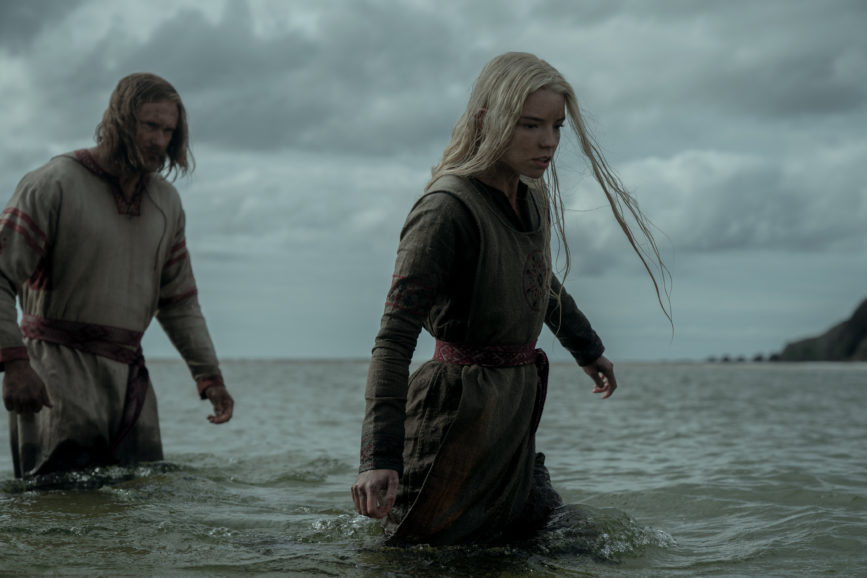
As they were also using a spot reflector and were on full spot, gelling the head became impossible, so the light was gelled after it left the mirror. This was achieved by an 8ftx 4ft alloy frame built into the rig. “The rig was then covered in black molton to combat any ungelled light leaks, and so our mobile, elevated, gelled moonlight keylight was born,” says Lynch.
SkyPanel S60s were bounced into a 20 x 12 muslin rigged on a rubber tracked 60ft cherry picker. When colour mixed to match the moonlight colour, this became a mobile and versatile fill machine. “18k Arrimax was gelled with our moonlight colour and used on full flood as back light,” he adds. “Many of these rigs were born out of necessity because we were shooting in locations that large mobile cranes could not access.”
To achieve the silhouette feel Blaschke wanted in the final fight scene, smoke was backlit with 20 No 12 light Maxi Brutes that were socaplex-fed to allow individual bulb control and covered with full CTO frames. The rivers of lava were then created using 60 SkyPanel S60s and 18 S120s, laid on their backs. “These ran into a pool of 36 No S360s and dimmer op Gino created a pulse to emulate the slow creep of lava flowing down a hill. VFX then laid flame over our lights,” says Lynch.
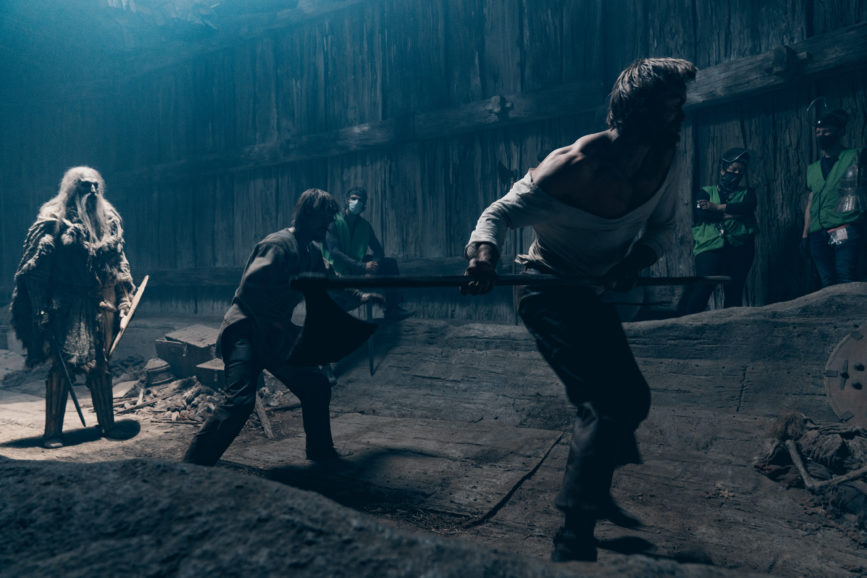
The sequence at the farm where Amleth escapes through the smoke hole, makes his way to the forge, and looks to Queen Gudrún (Nicole Kidman) was the most demanding to light as the whole farm and hill behind could be seen, meaning there was nowhere to hide lighting units.
“The challenge, as is often the case in such locations, is more about logistics than the lighting itself,” highlights Lynch. “We positioned six Arrimax on top of the cliff to light that scene, but it took three days traversing across difficult terrain to get our equipment up there.
“To fill the scene, we deployed five mobile SkyPanel bounced fill machines. We played two mirrored moons and a fire flicker behind in the longhouse, and one on the forge to complete the scene. To fit all of that around a Technocrane travelling on 30ft of track was a challenge for us all.”
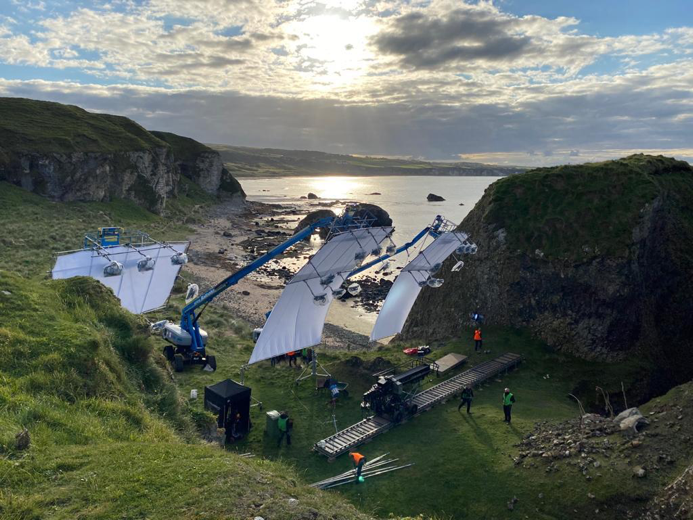
From fire flickers to battle scenes, the goal was always to be close to reality. During that process it was Eggers’ and Blaschke’s “integrity and devotion to storytelling” that Lynch found “picked everyone up and swept them along, making it without doubt the most gruelling and most enjoyable job” he’s undertaken.
“Having the right people in the right positions is key,” he says. “My Best Boy Ger O’ Hagan assembled some of the best technicians in the UK, without whom we wouldn’t have achieved any of this. I learnt the importance of prep time and testing and how to embrace a location, no matter how difficult, to achieve the best you can.”
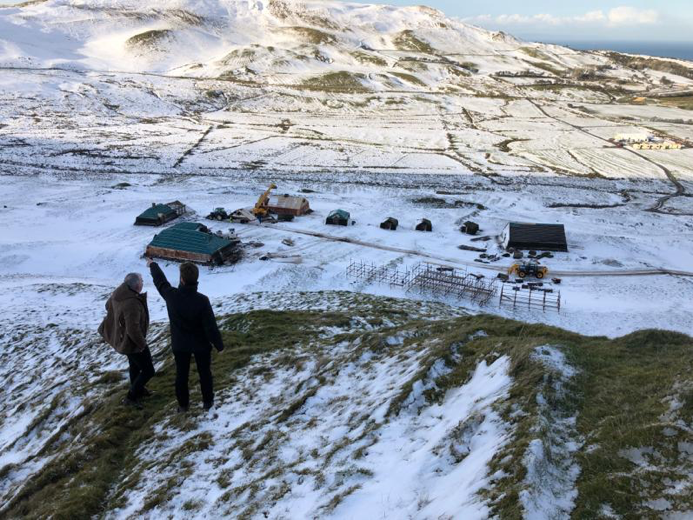
While the characters in The Northman experience a wild adventure, the crew and cast embarked on an enlightening and eventful journey throughout the shoot. “Half of what I know of cinematography comes from before The Northman, and the other half is from The Northman itself,” says Blaschke. “I’m going to keep honing the moonlight technique and see if I can find that collaborator to make a gel, or even better, a glass filter to put on a lamp. But It’s nice to have something successful from version one.
“Every movie also benefits from what came before it. This film wouldn’t exist in this form without The Lighthouse. Even though that’s black-and-white, it has a night texture to it, and is similar in the way the skin tone separates from other elements. The focus on this film was all about exaggerating that texture and bringing it into colour.”
Eggers could also “fill many volumes” articulating what he discovered making The Northman – a vast production with a learning experience of equal scope. “On the final day of shooting, Ethan Hawke put his arms around Jarin and I and said, ‘Congratulations, guys. You’ve done everything you can possibly do on this movie. Now you can make anything you want.’ And Jarin and I thought, ‘Yeah, now we have the experience to take our next movie to another level.’”



